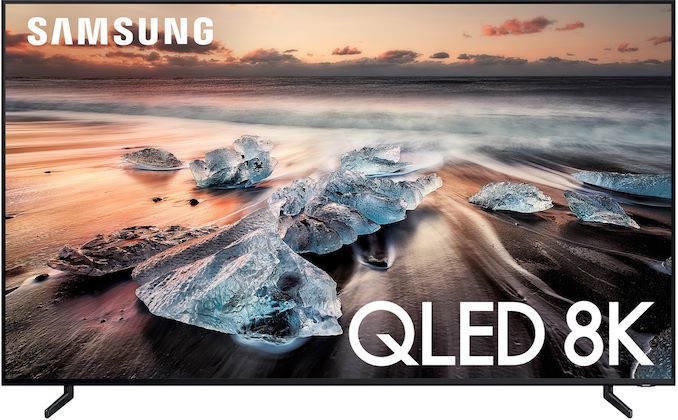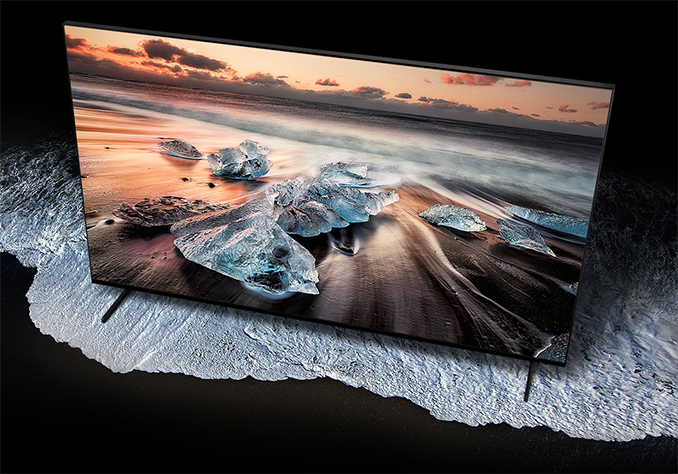Samsung’s 8K QLED TV 55-Inch: A More Affordable 8K Ultra-HD TV
by Anton Shilov on September 6, 2019 12:00 PM EST
Being flagship televisions available today, 8K Ultra-HD TVs not only feature a resolution of 7680×4320 pixels, but also pack all the latest technologies that manufacturers have to offer these days and therefore can provide ultimate experience even with 4K or 2K content. Samsung’s Q900 family of 8K TVs do exactly that, but because of its premium positioning, the company offered them in large sizes, which means price tags excessive for most. Up until this week.
At IFA, Samsung introduced its smallest 8K UHDTV to date: the Q900R 55-inch model QN55Q900RBFXZA, which costs significantly less than the rest of the SKUs in the lineup.
The television uses Samsung’s IPS-class 7680×4320 panel backed by a quantum dot-enhanced LED backlight that promises FALD-like operation, which Samsung dubs Direct Full Array 16X technology (in case of the 55-inch model). The TV features a peak brightness of 4000 nits, which is the maximum luminance at which HDR content is mastered these days. Speaking of HDR, the Q900-series officially supports HDR10, HDR10+, and HLG formats, but not Dolby Vision (at least for now). As far as color gamut is concerned, the Q900-series can reproduce 100% of the DCI-P3 space.
Just like its bigger brothers, the Samsung Q900R 55-inch uses the company’s Quantum Processor 8K as its brain. The SoC is responsible for all decoding, upscaling, and other operations. Among the capabilities of the chip that Samsung is particularly proud of is its proprietary 8K AI Upscaling technology, which is designed to enhance the quality of digital content to panel’s native resolution (does not work with PCs, games, analogue content, etc.). Furthermore, the SoC is also able to interpolate content to 240 FPS and supports AMD’s FreeSync/HDMI Variable Refresh Rate technologies.
Last but not least, the UHDTV comes with a 60-W 4.2-channel audio subsystem.
While technological excellence of Samsung’s Q900-series Ultra-HD televisions is well known, the key feature of the 55-inch model is its price. The 8K television carries a price tag of $2,499, which is in line with higher-end 4K TVs. Considering the fact that retail prices tend to fall below MSRPs, the 55-inch Q900 will likely be considerably more widespread than its larger counterparts.
Related Reading:
- 8K Association Sets Minimal Specs for 8K Ultra-HD TVs
- Sharp to Demonstrate 120-Inch 8K LCD TV & 8K TV with 5G Modem at IFA
- AU Optronics's New 85-Inch 8K LCD TV with 1,024-Zone Backlighting
- Samsung's 2019 QLED UHD TVs: 8K TVs Revamped, 4K TVs Get New Panel & Backlighting
- Samsung at CES 2019: 219-Inch and 75-Inch Micro LED Ultra-HD TVs Demonstrated
- Samsung Announces iTunes Movie & TV Show Support In Its 2018, 2019 Smart TVs
- Samsung Begins Sales of 65-Inch Q900R 8K UHDTV in the UK
- Samsung Starts to Take Pre-Orders on 85-Inch Q900 8K UHDTV
Source: Samsung











51 Comments
View All Comments
zodiacfml - Saturday, September 7, 2019 - link
I'd be all over this if I shoot photos with a full frame digital camera, mainly for displaying images. Otherwise, a 4k TV with decent specs will do.Oxford Guy - Tuesday, September 10, 2019 - link
Backlight quality is going to make a far larger impression (or OLED... some kind of non-backlit tech) than 8K over 4K.Color space coverage should be probably the top priority for innovation but, instead, people obsess over pixel size. At least things like OLED have fixed the static contrast ratio problem, unlike the tech like IPS which has really low contrast and glow.
MDD1963 - Saturday, September 7, 2019 - link
can't *wait* to pay extra now so I can very eagerly get started viewing all the plethora of 8k format movies available!!!! :/Santoval - Sunday, September 8, 2019 - link
55 inches is too small too see any benefit from 8K. Is there a gain from 8K? Sure, but only for 80"+ sizes. Below that size, unless you sit <1 m / 3 feet from the TV there is zero benefit. For a 55" size you would need to sit less than ~50 cm / ~20 inches close to see any benefit, i.e. computer monitor distance. At that distance vs that size your field of view would almost certainly be overwhelmed, so it might be best to step back a little. By doing that you also lost the resolution gain from the monitor use...In short 8K will be of use only for people who can afford (and have the room for) 80+ inch sizes, and only barely at first. You need to go to ~100"+ to see a clear advantage of 8K over 4K. That's just the reality of resolution vs size vs viewing distance. If the industry doubles on the insanity and moves to 16K in the future that's when the real fun will begin, since 150"+ monitors are probably not even possible (even if they were they probably cannot enter even big houses). You need (very bright) projectors to reach such sizes.
Alistair - Sunday, September 8, 2019 - link
We saw this silly argument with 4k tvs too, and everyone was wrong back then. 4k was especially a huge change in gaming. There are a lot of real time effects that add blurriness, and higher resolution causes the depth of field, the AA and more to all be much higher quality and improve the image. I don't think 8k will do much for movie watching, but it will definitely make a difference in gaming.stephenbrooks - Sunday, September 8, 2019 - link
If they ever do high field-of-view screens for gaming (like domes/hemispheres or at least half-cylinders), the 8K resolution is going to come in handy for giving detail across all angles.bug77 - Monday, September 9, 2019 - link
Actually, no, everyone was not wrong back then ;)You can't see differences between FHD and 4k at typical viewing distance _when looking at uncompressed content_.
When content gets compressed, FHD isn't really FHD anymore and 4k isn't really 4k. Add a pinch of oversharpening that will be less visible with smaller pixels and you'll see where theory and practice start to diverge.
Gaming is a different beast, let's stick to TVs here (even though consoles are used together with TVs).
Oxford Guy - Tuesday, September 10, 2019 - link
Fallacy.1080 was too little vs. 4K. There is a limit to human visual acuity. It doesn't magically go up because TV companies want to sell us new stuff.
thechrissmartin - Monday, September 9, 2019 - link
Does anyone feel that this is the same thing as the upcoming OnePlus TV?Soulkeeper - Monday, September 9, 2019 - link
Everytime they use the words "Quantum dot" or even just "Quantum" I think of Sulu and those commercials ... can't help it.